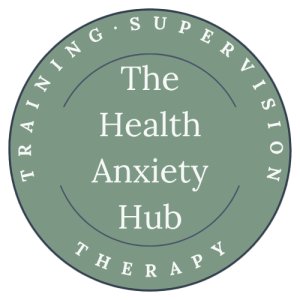The Health Anxiety House: Understanding Why You Worry So Much About Your Health
By Dr Sophie Gwinnett, Clinical Psychologist & Founder of The Health Anxiety Hub
If you live with health anxiety, you’ll know the exhausting cycle all too well: the sudden jolt of fear after noticing a new sensation, the frantic Google search, the reassurance that helps briefly… until it doesn’t. The worry returns, louder than before, whispering “But what if this time it’s serious?”
As a clinical psychologist, and someone who previously lived through health anxiety myself, I’ve spent years trying to make sense of why it grips so tightly, and how we can finally loosen its hold. Out of that work came my Health Anxiety Integration Model (HAIM). It’s a trauma-informed way to understand health anxiety that goes far deeper than the familiar “catastrophic thoughts” or “reassurance-seeking” cycles.
This model doesn’t just look at what’s happening now; it also explores why your mind learned to be this vigilant in the first place and it can be best understood through the metaphor of a house – click here to view
The House Metaphor
Imagine your mind as a house, a structure that’s been built and shaped over time. Health anxiety doesn’t arrive from nowhere, it’s built upon foundations that were often laid early in life and are maintained by thoughts, emotions and behavioural cycles, as well as by the systems and relationships around you.
The Foundations: Early Experiences
The foundations of your house represent your early experiences of care, safety, responsibility, illness, or loss.
Perhaps you grew up in a family where illness was a theme, either in yourself or in someone you love, leaving you feeling that the world, or your body, could change in an instant. Perhaps you felt responsible for others, learning that being alert kept people safe. Or maybe you grew up in an unsafe environment where your nervous system became wired to look out for danger.
Those early foundations can quietly teach your nervous system that vigilance equals safety. Fast forward to adulthood, and that same protective system may still be hard at work, scanning constantly for signs of danger in your body.
The Main Body of the House: The Maintenance Cycle
This is the part most traditional CBT models focus on, the cycle that keeps health anxiety going. People with health anxiety often describe getting caught in cycles of thoughts, emotions, behaviours and avoidance. Like wandering from room to room in a scary house, but not being able to find the exit.
It starts with a physical sensation or intrusive thought: “What if this headache is something serious?”. You become tightly fused with that thought, regarding it as important, factual, urgent. You feel anxious, your body tightens, your heart races, sensations that you believe confirm the fear. You might seek reassurance from a loved one, a doctor, or online. You feel better for a short while… until doubt creeps back in. The relief is temporary, but the vigilance grows stronger each time. You learn to avoid situations that might present triggers, but over time the anxiety grows, and your world shrinks as you work harder and harder to avoid the sensations of anxiety.
On this floor, we see the cognitive and behavioural loops – fusion with frightening thoughts, avoidance, checking and reassurance, that maintain the problem. But remember, this floor stands upon those early foundations of fear and responsibility.
The Attic Layer: The Wider Systems that Amplify Health Anxiety
The attic is the relational space that amplifies health anxiety.
Here, shame, invalidation and increased uncertainty live. The voice that says, “Just stop worrying, it’s all in your head,” or the healthcare system that either makes you feel dismissed or sends you for repeated investigations and tests that prolong uncertainty.
Partners or family might not understand, friends might roll their eyes, healthcare professionals might dismiss you. Shame is added into the pot of health anxiety, fuelling further weight to your distress.
These experiences don’t just make you feel worse, they can reinforce the very patterns of self-monitoring and anxiety you’re trying to escape. Because shame makes us turn inward, cutting us off from the connection and compassion that can actually help us to heal.
A Trauma-Informed Lens: From Blame to Understanding
When we view health anxiety through this model, we move away from “what’s wrong with me?” to “what happened to me?”. We can be curious about our experiences, both past and present, that enabled this protective part of us to develop.
Health anxiety isn’t madness or weakness. It’s protection that began as wisdom. Somewhere deep down, your system learned that to stay safe, you must stay alert. The problem is that now, that protection is overworking, like a loyal guard dog barking at every creak in the floorboards.
My role as a psychologist isn’t to tell you that your thoughts are irrational, or to give you a strict set of behavioural guidelines that can fuel further distress. My role is to work with you to understand why this protective part understandably arose, process those earlier experiences so they no longer impact you today, and to help you to craft conversations with loved ones and healthcare practitioners that build safety and don’t sustain the anxiety cycles.
Together, brick by brick, we will rebuild your house so it feels like a home again, one that’s grounded in safety, security and connection.
Learn More
To book a free 15-minute phone call with me and to discuss therapy options, click here

